 Nothing like sitting in a bar alone, juz you and ur music. where everyone knows ur name.. it can be a drink you have on ur own or with a group of people. Just like wine... beer too has its requisits not just open mouth and swallow. As beers of different styles have distinctive characteristics, the appropriate glasses for each style will be the ones that accentuate those characteristics. As a rule, the more distinctive the beer, the more distinctive the glass should be.
Nothing like sitting in a bar alone, juz you and ur music. where everyone knows ur name.. it can be a drink you have on ur own or with a group of people. Just like wine... beer too has its requisits not just open mouth and swallow. As beers of different styles have distinctive characteristics, the appropriate glasses for each style will be the ones that accentuate those characteristics. As a rule, the more distinctive the beer, the more distinctive the glass should be. 
So here is the list of beer glasses....and the purpose
Flute
Tall, thin, footed with a short stem, often gold-rimmed. These glasses are delicate, and show off a beer’s lean, sparkling body. This makes them inappropriate for heavy, murky beers, but perfect for light, sparkling beers such as fruit lambics and north German pilsners.
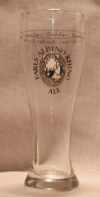 Lager glass
Lager glassShort glasses, holding no more than 12 oz of beer. The are slightly wider at the mouth than at the foot, with gradual, evenly sloping sides. This unpretentious glass is a great basic drinking vessel, well-suited to pale lagers such as American standards, dortmunders, and helles. Lighter Vienna, American darks, cream ales and mainstream golden ales are also fine in this blue collar glass.
 Kölsch/Altbier
Kölsch/AltbierSimilar to the Lager glass, with straight-sided, and generally a little bit smaller. The Kölsch glass in particular has a revolver-type look when six of them are crowded onto a server’s tray. These are designed to be drained in a couple of gulps, which is a good way to drink an Alt or Kölsch once you’ve written your notes. Alt glasses are slightly shorter and fatter than the Kölsch glasses. Both allow for billowing heads to form, but are kind of lousy for developing aroma or discerning subtleties, which is a shame when you’re sitting in Im Füchschen trying to wrap your head around their glorious brew.
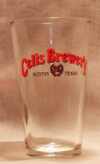 Shaker
ShakerThe American microbrewer’s standard. A gently sloped 16 oz. glass made for session-type beers. Ambers, English & American pales, and sometimes darker session ales are typically served in these glasses, which are better known for their durability, than for any particularly beneficial properties. It is for that reason that some beer geeks have developed a hatred of the shaker.
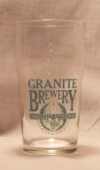 English pint
English pintThese have a similar purpose to the shaker in that they are made for session ales, in this case bitters, milds, porters and stouts. There are a couple of key differences. First, they pour a proper pint (and usually have a line indicating where that is on the glass, just to make sure you don’t get ripped off). Second, they have a bit more flourish than the bland shaker. There are basically two variations. The first has a gentle curve covering the upper 2/3 of the glass - Guinness uses these. The second has a straight slope for the bottom two-thirds, and then a bump near the top, flattening out at the mouth of the glass.
Dimpled mug
A classic in North America, the dimpled mug is a large mug, with dimples, and a handle. It is convex, with the mouth larger than the base. The glass is thick, so bar owners love it. While the dimples make appreciating the appearance of the beer more difficult, the wide mouth releases the aroma just nicely. So while these mugs are most commonly used for raunchy lagers, I would recommend them more for aromatic brown ales (especially the hazy ones), bocks and other dark lagers.
Stein
By far the most ornate beer vessels are the Bavarian steins. These are usually ceramic, earthenware or stoneware, and are intricately decorated with scenes of nature, castles, and villages. They come in a variety of sizes, usually 1/2L, 1L, or 2L - the preferred portions of Bavarian drinkers. While steins do nothing for the appearance of the beer, there is little question that these beautiful pieces of folk art (even if they are made in a factory, they’re still pretty nice) are visually appealing unto themselves. The aromatic aspect is admittedly not as strong from these materials as from glass, but the taste is unencumbered. Thankfully, some steins have lids, which you can use to trap aromas in so that when you open the lid you get a big shot of malt (or smoke, if you are drinking rauchbier). The added bonus of the lid is that you keep blackflies and mosquitoes out of your Molson if you’re camping, and the cigarette smoke out if you’re in a low-ceilinged cellar bar in Germany. Use for any traditional German lager style.
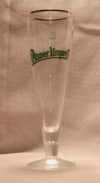 Footed Pilsner
Footed PilsnerA small, almost straight-sided glass sits on an inch-long stem and foot. The basest form of this glass is actually kind of dull, but thankfully brewers like Christoffel have added tulipesque accents to liven things up. The basic footed pilsner has a slightly bulbous bottom and narrower mouth, which makes it better for drinking than for smelling, and places the most emphasis on the appearance. It has a bit more style than some other glasses, so it is best used for pilsners, and decent cream or golden ales than for the lowliest lagers.
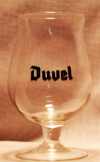 Tulip
TulipThe most varied glass in the world of beer. This style of glass has been around a while but only recently has found in a home in the eyes of beer-lovers the world over. It is the ultimate beer-tasting utility glass. The bulbous bottom makes for great drinking, the flared mouth allows for wonderful head formation and aroma release, and while it is short enough to handle the biggest beer styles, it is tall enough to service IPAs and other complex session beers. The Duvel glass is a well-known variant of the tulip style, and the Ratebeer tasting glass is an almost perfect example.
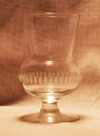 Thistle
ThistleA somewhat obscure glass, used by the Belgians for scotch ales. It is a footed glass, with a short stem. The glass starts very bulbous, as though it were a snifter, but then the upper half has straight sides that angle outwards. The mouth is basically the same radius at the bulb at the bottom. While it has a funky look to it, I’m not really sure what benefits it brings to the table otherwise - the funny shape I think would make drinking almost awkward, while the mouth is not wide enough to provide ample aroma.
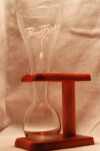 Yard of Ale
Yard of AleIn some ways, this is merely an elongated version of the thimble. True, is has no foot nor stem, but is consists of a bulb followed by a long, thin, outwardly sloping section, which in this case flattens out at the end. Originally, these were passed to stagecoach drivers so that they could stop for a drink without giving up the reigns (thus, the world’s first drive-through was an inn somewhere in Industrial Revolution England). Because the bottom is both bulbous and stemless, it will not stand on its own, and requires a wooden stand. The best-known branded example if Pauwel Kwak.
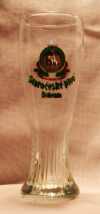 Weizen
WeizenThe classic German wheat beer glass is tall, narrow and flared at the top. This design accentuates both the hazy appearance of a classic hefeweizen, but also allows for abundant head formation. They typically hold 1/2L of beer. The one drawback to these glasses is that with so much glass exposed to the atmosphere, the beer warms more quickly than one might like on a hot summer’s day.
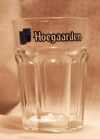 Tumbler
TumblerBest known as "the Hoegaarden glass", tumblers are session glasses with a very gentle straight slope, though the Hoegaarden glass itself has a wider bowl at the top of the glass. These graceless glasses are used for witbiers to highlight the hard-working farm origins of the style. To the amazement of North Americans, they are also used in Belgium for gueuze. We should all be so lucky as to have gueuze and lambic as local, working class session brews!
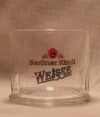 Bowl
BowlUsed for berliner weissebier, the bowl is a low-slung, wide glass that you could very much each muesli and yoghurt out of. This glass is all style, but works well with the berliner weisse when that style is adulterated by the woodruff or raspberry syrup. Then it is practically an alcopop, and such an absurb drinking vessel makes sense. Jackson’s Ultimate Beer book shows the berliner weissebiers in a stemmed version of the bowl (almost a bolleke, which is really a cross between a bowl and a Trappist glass), and the additional elegance of the stem seems to fit well a berliner weisse taken neat.
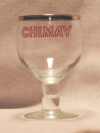 Trappist glass
Trappist glassBowl glasses with feet and long stems, Trappist glasses work well with the complex abbey ales they are designed for. First, they have very wide mouths, which allows the copious foam to develop without getting too thick for proper drinking. These wide mouths allow the complex aromas of abbey ales to fully realize. The deep bowl shows off the liquid well, and makes even the murkiest Rochefort look damn fine.
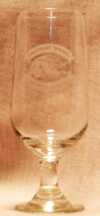 Stem glasses
Stem glassesSurprisingly common, yet unknown style. These are typically shorter, smaller with stems and the glass portion is slightly off-straight in its trajectory. They usually have some convexity, but not much. Occasionally, they are dead straight, with rounded bottoms to form basically a square. Celebrator and Harvey Porter use these types of glasses.
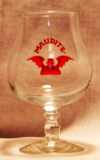 Snifter
SnifterWhether a pure brandy snifter or a variant, these are used most commonly for barley wines, eisbocks and imperial stouts. They are stemmed and footed, bulbous at the bottom and narrowing all the way to the top. Because barley wines often have little head formation, the narrow mouth is fine as far as that goes, but still inhibits aroma a little bit, the tradeoff being the appearance of elegance. Many snifter variants made for beers have wider-than-average mouths for this reason.
1 comment:
Vadai, Why never invite me for a drink? Last saw you over 8 months ready
Post a Comment